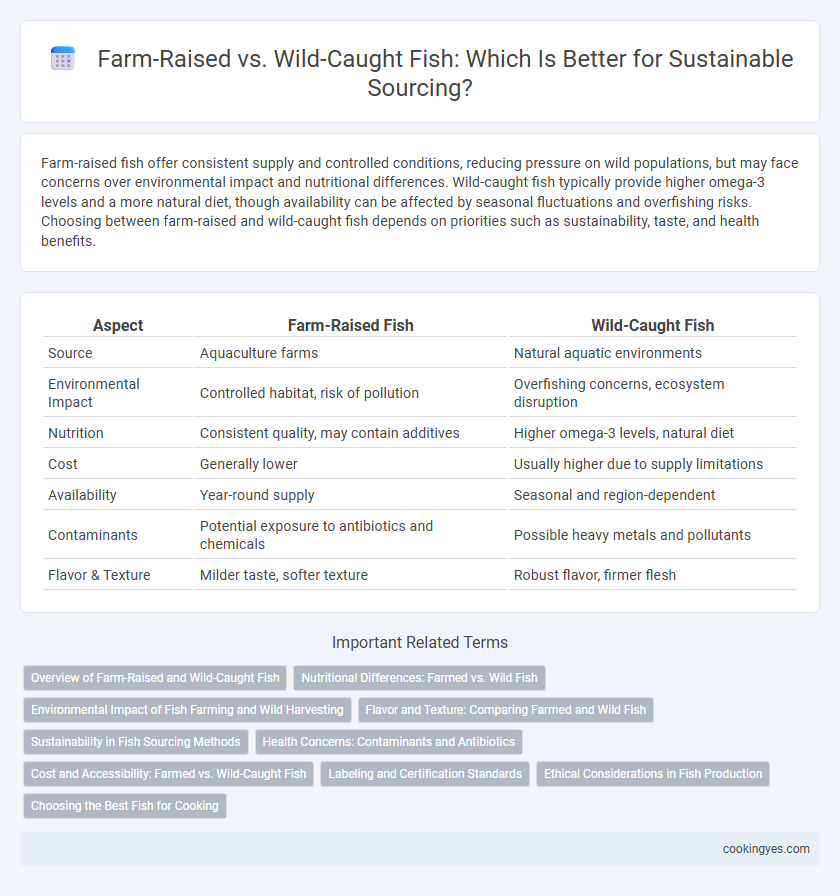Farm-raised fish offer consistent supply and controlled conditions, reducing pressure on wild populations, but may face concerns over environmental impact and nutritional differences. Wild-caught fish typically provide higher omega-3 levels and a more natural diet, though availability can be affected by seasonal fluctuations and overfishing risks. Choosing between farm-raised and wild-caught fish depends on priorities such as sustainability, taste, and health benefits.
Table of Comparison
| Aspect | Farm-Raised Fish | Wild-Caught Fish |
|---|---|---|
| Source | Aquaculture farms | Natural aquatic environments |
| Environmental Impact | Controlled habitat, risk of pollution | Overfishing concerns, ecosystem disruption |
| Nutrition | Consistent quality, may contain additives | Higher omega-3 levels, natural diet |
| Cost | Generally lower | Usually higher due to supply limitations |
| Availability | Year-round supply | Seasonal and region-dependent |
| Contaminants | Potential exposure to antibiotics and chemicals | Possible heavy metals and pollutants |
| Flavor & Texture | Milder taste, softer texture | Robust flavor, firmer flesh |
Overview of Farm-Raised and Wild-Caught Fish
Farm-raised fish are cultivated in controlled environments such as tanks or ponds, allowing for consistent supply, faster growth rates, and reduced pressure on wild populations. Wild-caught fish are harvested directly from natural habitats like oceans, rivers, and lakes, offering higher biodiversity and often more complex nutritional profiles but raised sustainability concerns. Both sourcing methods impact ecosystem health, fish quality, and market availability, influencing consumer choices and environmental policies.
Nutritional Differences: Farmed vs. Wild Fish
Farm-raised fish generally contain higher levels of omega-6 fatty acids, while wild-caught fish offer a richer profile of omega-3 fatty acids, essential for cardiovascular health. Wild fish typically have lower fat content but provide more vitamins such as vitamin D and minerals like selenium. Differences in diet and environment influence the concentration of antioxidants, with wild fish often exhibiting higher levels compared to farm-raised counterparts.
Environmental Impact of Fish Farming and Wild Harvesting
Fish farming, or aquaculture, often leads to habitat disruption, water pollution, and the spread of diseases affecting wild populations. Wild-caught fishing can result in overfishing, bycatch, and damage to marine ecosystems like coral reefs and seafloor habitats. Sustainable practices such as responsible farming techniques and regulated fishing quotas help mitigate environmental impacts in both sourcing methods.
Flavor and Texture: Comparing Farmed and Wild Fish
Farm-raised fish often have a milder flavor and a softer, more uniform texture due to controlled diets and environments, while wild-caught fish typically exhibit a stronger, more complex taste with firmer flesh resulting from natural foraging and active lifestyles. Species such as salmon and sea bass demonstrate pronounced differences, with wild variants offering richer flavors and more pronounced muscle structure. Consumer preferences may vary, but chefs frequently favor wild-caught fish for texture diversity and depth of flavor in culinary applications.
Sustainability in Fish Sourcing Methods
Farm-raised fish often offer a more sustainable option by reducing pressure on wild populations and enabling controlled breeding practices that minimize environmental impact. Wild-caught fish sourcing can threaten ocean ecosystems if not managed properly, leading to overfishing and habitat destruction. Sustainable fisheries certification programs and responsible aquaculture techniques play a vital role in promoting eco-friendly fish sourcing methods.
Health Concerns: Contaminants and Antibiotics
Farm-raised fish often contain higher levels of contaminants such as PCBs and heavy metals due to dense farming conditions and feed composition, raising health concerns for consumers. The routine use of antibiotics in aquaculture can lead to antibiotic residues in fish and contribute to antibiotic resistance, posing additional risks. Wild-caught fish generally have lower antibiotic exposure but may still accumulate environmental pollutants depending on their habitat, making source verification crucial for health-conscious choices.
Cost and Accessibility: Farmed vs. Wild-Caught Fish
Farm-raised fish generally offer a lower cost and greater accessibility compared to wild-caught fish due to controlled breeding environments and consistent supply chains. Wild-caught fish tend to be more expensive and less available because of seasonal variations, fishing regulations, and environmental factors. Consumers seeking affordability and year-round availability often prefer farmed fish, whereas wild-caught fish appeal to those prioritizing natural habitat sourcing despite higher prices.
Labeling and Certification Standards
Farm-raised fish often carry certifications such as ASC (Aquaculture Stewardship Council) or GLOBALG.A.P., indicating adherence to sustainable farming practices and responsible resource management. Wild-caught fish are typically labeled according to certifications like MSC (Marine Stewardship Council), which verify sustainable fishing methods and stock health. Clear labeling helps consumers make informed decisions by providing transparency about the fish's origin, ensuring environmental and quality standards are met.
Ethical Considerations in Fish Production
Farm-raised fish raise concerns about environmental impacts such as habitat destruction, water pollution, and antibiotic use, which can affect ecosystem health and biodiversity. Wild-caught fish sourcing faces challenges in preventing overfishing and ensuring sustainable population levels, critical for maintaining fish stocks and marine balance. Ethical fish production requires strict adherence to sustainable practices, transparency, and minimizing harm to aquatic environments and local communities.
Choosing the Best Fish for Cooking
Farm-raised fish offer consistent quality and availability with controlled diets that enhance flavor and texture, making them ideal for precise cooking techniques. Wild-caught fish provide a natural diet rich in nutrients and a more varied flavor profile, favored for authentic taste in recipes. Selecting between farm-raised and wild-caught depends on desired flavor intensity, sustainability concerns, and specific culinary applications.
Farm-raised vs Wild-caught for fish sourcing Infographic

 cookingyes.com
cookingyes.com